Translate this page into:
Mitigating the Risk of Dengue Fever in Nagpur City, India: Insights from a Five-year Retrospective Study
*Corresponding author: Gyanshankar Mishra, Department of Respiratory Medicine, Indira Gandhi Government Medical College, Nagpur, Maharashtra, India. gpmishra81@gmail.com
-
Received: ,
Accepted: ,
How to cite this article: Mulani J, Mishra G, Nimgade S, Bahirwar NM, Balasubramanian R. Mitigating the Risk of Dengue Fever in Nagpur City, India: Insights from a Five-year Retrospective Study. Vidarbha J Intern Med. 2023;33:63-72. doi: 10.25259/VJIM_7_2023
Abstract
Objectives:
Dengue is a significant global threat, with millions of infections yearly, primarily transmitted by Aedes mosquitoes. Vector control is crucial as no specific treatment is available, and urbanisation has led to increased susceptibility to the disease. We aimed to study dengue fever’s incidence, mortality, and various determinants in Nagpur, India.
Material and Methods:
This was a retrospective record-based study conducted for the period between January 2018 and December 2022 in Nagpur, India.
Results:
During 2018–2022, 17,306 blood samples were tested for dengue immunoglobulin M antibodies by enzyme-linked immunosorbent assay method with 2470 positive results indicating an overall test positivity of 14.27%. A median of 27 samples was tested monthly (interquartile range [IQR]: 5–178.5) with seven dengue cases (IQR: 1–15) diagnosed per month, yielding a monthly median dengue test positivity rate of 15.3 % (IQR: 6.41–24.28). Median annual dengue incidence rate (per 1,00,000 population) was 20.12 (IQR: 21.46). The median dengue-attributable death yearly was 2 (IQR: 2.25), remaining stable over the study period. The mean annual case fatality rate (CFR) was 0.43% (standard deviation [SD]: 0.34%). During the same period, India’s mean annual dengue incidence rate (per 1,00,000 population) was 1.74 (SD: 0.81), and the mean annual CFR was 0.134 % (SD: 0.042). During the five years, action was taken on 194,698 containers. The median values of environmental factors and public health interventions, as calculated on a monthly basis, were as follows: Container index: 1.15 % (IQR: 0.7–1.98); action taken on containers: 3108.5 (IQR: 2436–4282); house index: 3.02 % (IQR: 2–4.07); guppy fishes introduced: 1736.5 (1005.5–1794.5) and rainfall (mm): 26.05 (1–69.11). The total number of dengue cases, incidence rate, and CFR showed an overall decline in year-wise evaluation. The important determinants identified were as follows: Higher container index, house index, and total blood samples tested for dengue were significant determinants of the total number of dengue cases, and environmental factors such as Aedes density, container index, and house index were significant determinants of dengue-related mortality. Introducing guppy fishes and taking action on containers successfully arrested the absolute number of dengue deaths. The container index, house index, and rainfall were significant determinants of Aedes’ density.
Conclusion:
Our study emphasises the effectiveness of public health interventions in reducing the incidence and fatality rate of dengue fever in Nagpur City over the past five years, particularly through introducing guppy fish and container management. Stagnant water around households has been identified as a significant risk factor for dengue transmission. Prevention strategies must prioritise tackling this issue, with enhanced monitoring during the wet season, and encourage community members to take personal responsibility for eliminating stagnant water sources in their households.
Keywords
Dengue
Nagpur
Aedes
Vector control
Public health interventions
INTRODUCTION
Dengue, a mosquito-borne viral infection, poses a significant threat to humans worldwide, with an estimated 100–400 million infections annually. While most dengue cases are asymptomatic or cause mild illness, severe dengue cases can be fatal. Aedes aegypti and Aedes albopictus mosquitoes are the primary vectors responsible for the transmission of the virus.[1] To control dengue, vector control is critical, as no specific treatment is available. In India, there is a significant discordance between reported and modelled incidence rates, making it challenging to assess the true burden of the disease.[2] Previous Indian studies have shown a seroprevalence of 56.9% in the general population and a case fatality ratio of 2.6% among laboratory-confirmed cases.[3] In light of the escalating urbanisation trend, the population dynamics have undergone a significant shift, with a heightened number of individuals inhabiting densely populated endemic regions now susceptible to the pathogenic agents that give rise to dengue fever. The present study aimed to evaluate the incidence, mortality comprehensively, and various determinants of dengue fever in the urban environment of Nagpur City in central India.
MATERIAL AND METHODS
The current investigation was a retrospective observational analysis spanning a period of 5 years, from January 2018 to December 2022, in Nagpur City, India. To collect relevant data, reports of all blood samples tested for dengue immunoglobulin M (IgM) antibody by enzyme-linked immunosorbent assay (ELISA) method during the study period were obtained and duly recorded. In addition, monthly rainfall data were procured from the Regional Meteorological Centre, Nagpur, and monthly dengue indicators, other environmental factors, and public health intervention indices were acquired from the archives of Nagpur Municipal Corporation. Moreover, the number of reported dengue cases and dengue-linked fatalities were retrieved from the records of Nagpur Municipal Corporation. Furthermore, data concerning the Dengue cases and deaths reported throughout India during the study period were obtained from published data from the National Centre for Vector-Borne Diseases Control, Government of India.[4] To compute the incidence rate accurately, population statistics for Nagpur and India were obtained from the United Nations-World Population Prospects, taking into consideration the anticipated population growth rate derived from the most recent population census figures.[5,6]
Case definitions
In this study, various key terms were defined for the purpose of clear and precise communication. The dengue test referred to the serum dengue IgM antibody test carried out using the ELISA method. A dengue case was defined as any dengue case that had been notified and confirmed through the serum Dengue IgM antibody test by the ELISA method. The dengue test positivity rate was the proportion of positive results for dengue infection among the serum dengue IgM antibody tests by the ELISA method. Dengue incidence rate refers to the number of new dengue cases reported in a population (per 1,00,000 population) over a specific period, typically a year. It was calculated by dividing the number of new cases by the total population at risk and multiplying by 100,000.
A dengue death refers to a confirmed case of dengue in which the individual’s death was determined through a death audit to be attributable to the dengue infection. The dengue case fatality rate (CFR) is the number of dengue deaths as a proportion of the total number of notified dengue cases within a specific period, such as monthly or yearly.
The Nagpur city study quantified the Aedes mosquito population density by counting the number of mosquitoes captured per hour across multiple sites. The container index and house index were used to measure Aedes abundance in the area. The container index is the proportion of examined containers found to have Aedes larvae. The housing index is the proportion of inspected houses found to harbour Aedes larvae.
Actions taken on containers involved identifying and eliminating or treating potential breeding sites for Aedes mosquitoes, such as flower pots, discarded tires, and water storage containers in households, public spaces, and other areas where people may be at risk of mosquito exposure. Introducing guppy fishes as a public health intervention refers to adding guppy fishes to stagnant or collected waters to control mosquito larvae.
Statistical analysis
We utilised, Medcalc statistical software (version 20.215) to investigate study-related variables comprehensively.[7] Summary statistics were utilised to encapsulate the dataset concisely, including mean and standard deviation (SD) for normally distributed variables and median and interquartile range (IQR) for non-normally distributed variables. Both univariate and multivariate regression analyses were conducted to identify crucial determinants of dengue parameters, and each significant determinant was analysed with its corresponding correlation coefficient, P-value, and regression coefficient. P < 0.05 was deemed statistically significant, and only clinically relevant and significant determinants were presented. The univariate regression analysis employed a graphical representation utilising a heat map and scatter plots to illustrate the linear relationship between the two variables. Furthermore, to visually compare the patterns of dengue incidence rate and CFR over the five years from 2018 to 2022, both Nagpur City and the entire country of India were analysed and represented graphically. This approach facilitated a comprehensive dataset analysis, identifying significant patterns and insights contributing to advancing our understanding of dengue and its determinants.
RESULTS
Over five years, from January 2018 to December 2022, 17,306 blood samples were screened for Dengue IgM; among them, 2470 tested positive for dengue, resulting in an overall positivity rate of 14.27%. Notably, the median dengue incidence rate per 100,000 population per year in Nagpur City during this period was 20.1200 (IQR: 21.4625). By comparison, India’s mean dengue incidence rate was 1.7360 cases/100,000 individuals (SD: 0.8109). Further, details on monthly dengue indicators and environmental factors are presented in Table 1. During the studied 5-year period, 194,698 actions were taken on containers in Nagpur city.
| Variable | Median (IQR) |
|---|---|
| Number of samples tested per month | 27 (5–178.5) |
| Number of samples testing positive for Dengue (Serum IgM +) per month | 7 (1–15) |
| Dengue positivity rate per month (%) | 15.3010 (6.4121–24.2778) |
| Container index per month (%) | 1.15 (0.70–1.98) |
| Action taken on containers per month | 3108.5 (2436.0–4282.0) |
| House index per month (%) | 3.02 (2.00–4.07) |
| Introduction of guppy fishes per month | 1736.5 (1005.5–1794.5) |
| Rainfall per month (mm) | 26.0500 (1.0000–69.1135) |
IQR: Interquartile range
Mortality
Over the five years, dengue-attributable deaths were reported in 11 patients. The median number of dengue-attributable deaths per year was 2, with an IQR of 2.25, while the CFR per year was 0.4340% (SD: 0.3438%). During the same period, India’s mean annual CFR was 0.134 (SD: 0.042).
Year-wise trend
A detailed portrayal of the temporal evolution of dengue cases, fatalities, incidence rate, and CFR over a quinquennial span in Nagpur City is exhaustively demonstrated in Figure 1, which further encompasses a comparative analysis of dengue incidence rate and CFR in Nagpur City versus the entire country of India. Nagpur exhibited a higher incidence rate and CFR than India.
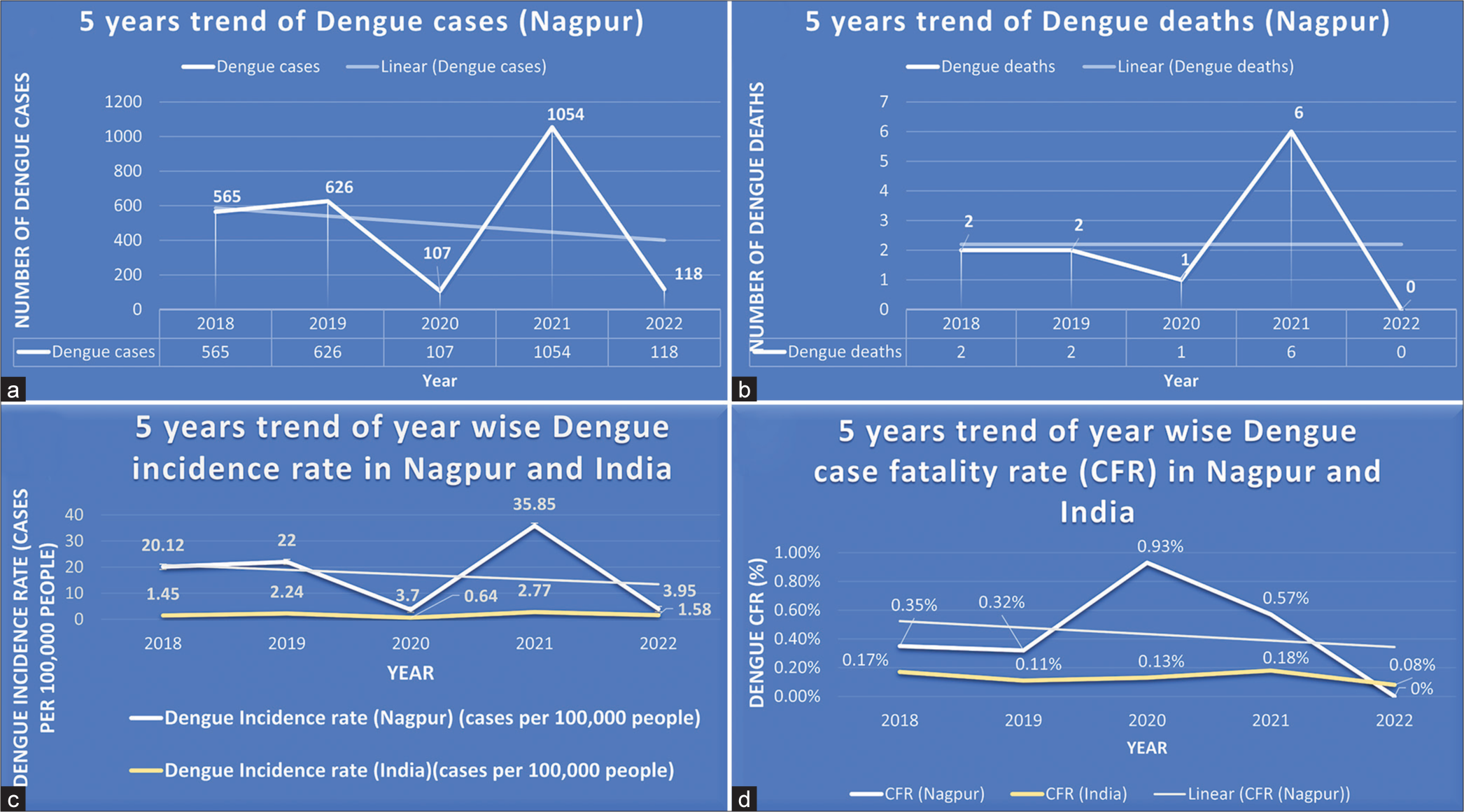
- Five years trend of (a) dengue cases (Nagpur), (b) dengue deaths (Nagpur), (c) dengue incidence rate (Nagpur and India), and (d) dengue case fatality rate (Nagpur and India).
Our analysis has uncovered that during the five years between 2018 and 2022, Nagpur City witnessed a downward trajectory in the number of dengue cases, incidence rate, and CFR. We also note that the absolute number of dengue-related deaths has not significantly increased and has remained relatively stable during this period.
Significant determinants
Our study has successfully revealed several crucial determinants of various dengue-related parameters, such as the total number of dengue cases, dengue test positivity rate, dengue-related mortality, and Aedes density, which is regarded as the most significant environmental factor that directly contributes to the spread of dengue infection. These important findings are meticulously presented in Table 2 of this study. The univariate linear relation of these determinants with the related dependent variables is depicted in Figures 2-5. The overall interplay among the various dengue-related parameters and their determinant is depicted in Figure 6.
| Serial number | Parameters (Monthly) | Significant determinants (Monthly) | Correlation coefficient (r) | P value | Regression coefficient | |
|---|---|---|---|---|---|---|
| 1. | The total number of blood samples tested positive for Dengue IgM ELISA (Dengue cases) | Univariate regression analysis | ||||
| Container index | 0.54 | <0.001 | 33.8932 | |||
| House index | 0.42 | 0.001 | 18.6414 | |||
| Total number of blood samples tested (Dengue IgM ELISA) | 0.82 | <0.001 | 0.1375 | |||
| Multivariate regression analysis | ||||||
| Total number of blood samples tested (Dengue IgM ELISA) | - | <0.0001 | 0.1034 | |||
| 2. | Dengue test (Serum IgM) positivity rate | Univariate regression analysis | ||||
| House index | 0.26 | 0.001 | –0.7641 | |||
| Total number of blood samples tested (Dengue IgM ELISA) | 0.52 | <0.001 | –0.003108 | |||
| 3. | Number of dengue deaths | Univariate regression Analysis | ||||
| Aedes density | 0.31 | 0.016 | 0.09606 | |||
| Dengue case fatality rate | 0.60 | <0.001 | 0.5793 | |||
| Container index | 0.34 | 0.007 | 0.1751 | |||
| Number of guppy fishes introduced (Negative correlation) | 0.29 | 0.023 | –0.0000471 | |||
| House index | 0.31 | 0.015 | 0.1017 | |||
| The total number of blood samples tested positive for Dengue IgM ELISA (Dengue cases) | 0.38 | 0.003 | 0.00467 | |||
| Multivariate regression analysis | ||||||
| Action taken on containers | 0.0237 | –0.000007227 | ||||
| Dengue case fatality rate | 0.0017 | 0.1565 | ||||
| The total number of blood samples tested positive for Dengue IgM ELISA (Dengue cases) | 0.0004 | 0.004499 | ||||
| Total number of blood samples tested (Dengue IgM ELISA) | 0.0080 | –0.0003356 | ||||
| 4. | Aedes density | Univariate regression Analysis | ||||
| House index | 0.62 | <0.001 | 0.5354 | |||
| Container index | 0.74 | <0.001 | 1.3531 | |||
| Rainfall (mm) | 0.66 | <0.001 | 0.007388 | |||
| Multivariate regression analysis | ||||||
| Container Index | <0.0001 | 0.7660 | ||||
| Rainfall (mm) | <0.0001 | 0.004175 | ||||
ELISA: Enzyme-linked immunosorbent assay
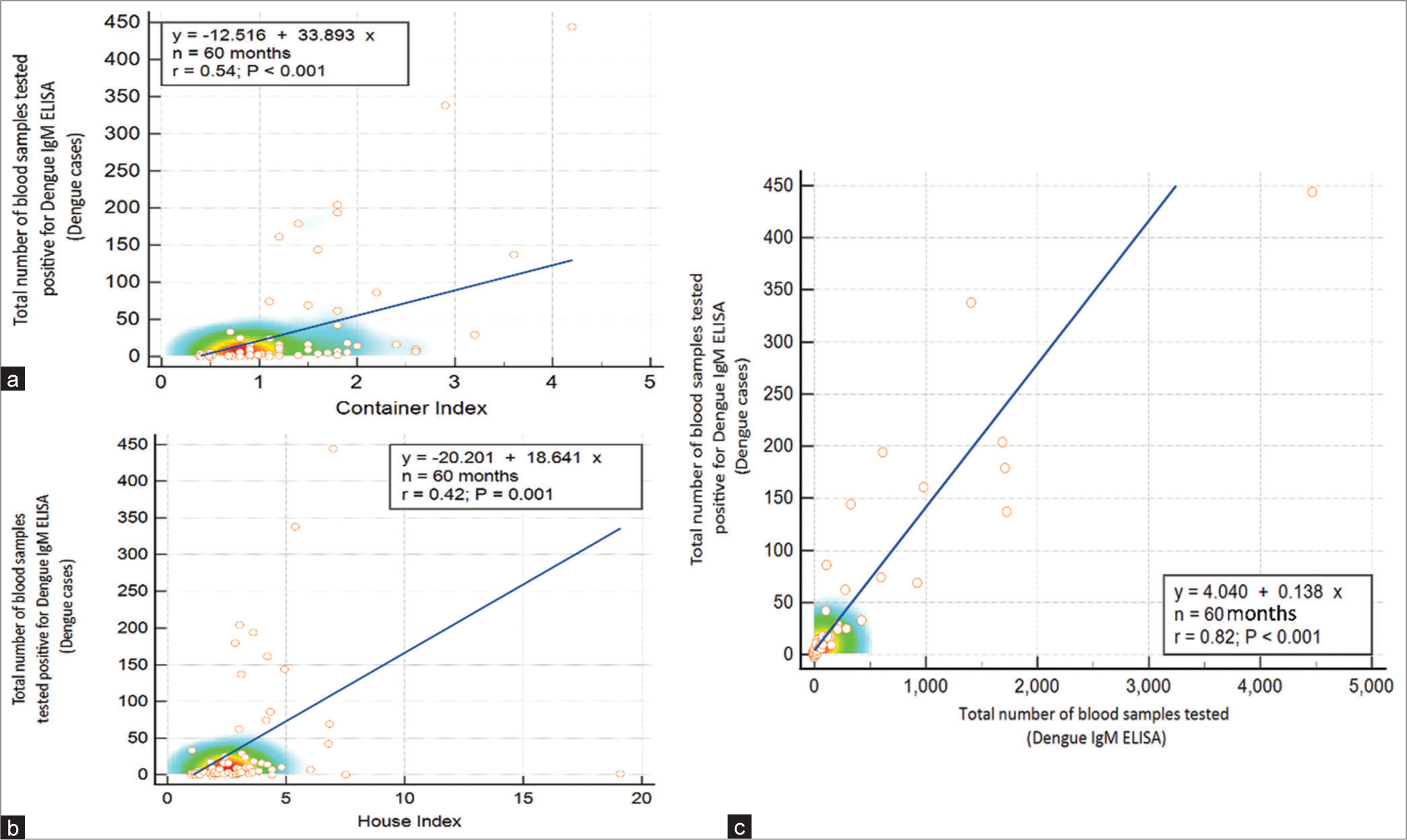
- Heat map and scatter plots depicting the linear relationship between the total number of blood samples tested positive for dengue immunoglobulin M (IgM) enzyme-linked immunosorbent assay (ELISA) (Dengue cases) as the dependent variable and the independent variables: (a) the total number of blood samples tested (Dengue IgM ELISA), (b) the container index and (c) the house index (month wise).
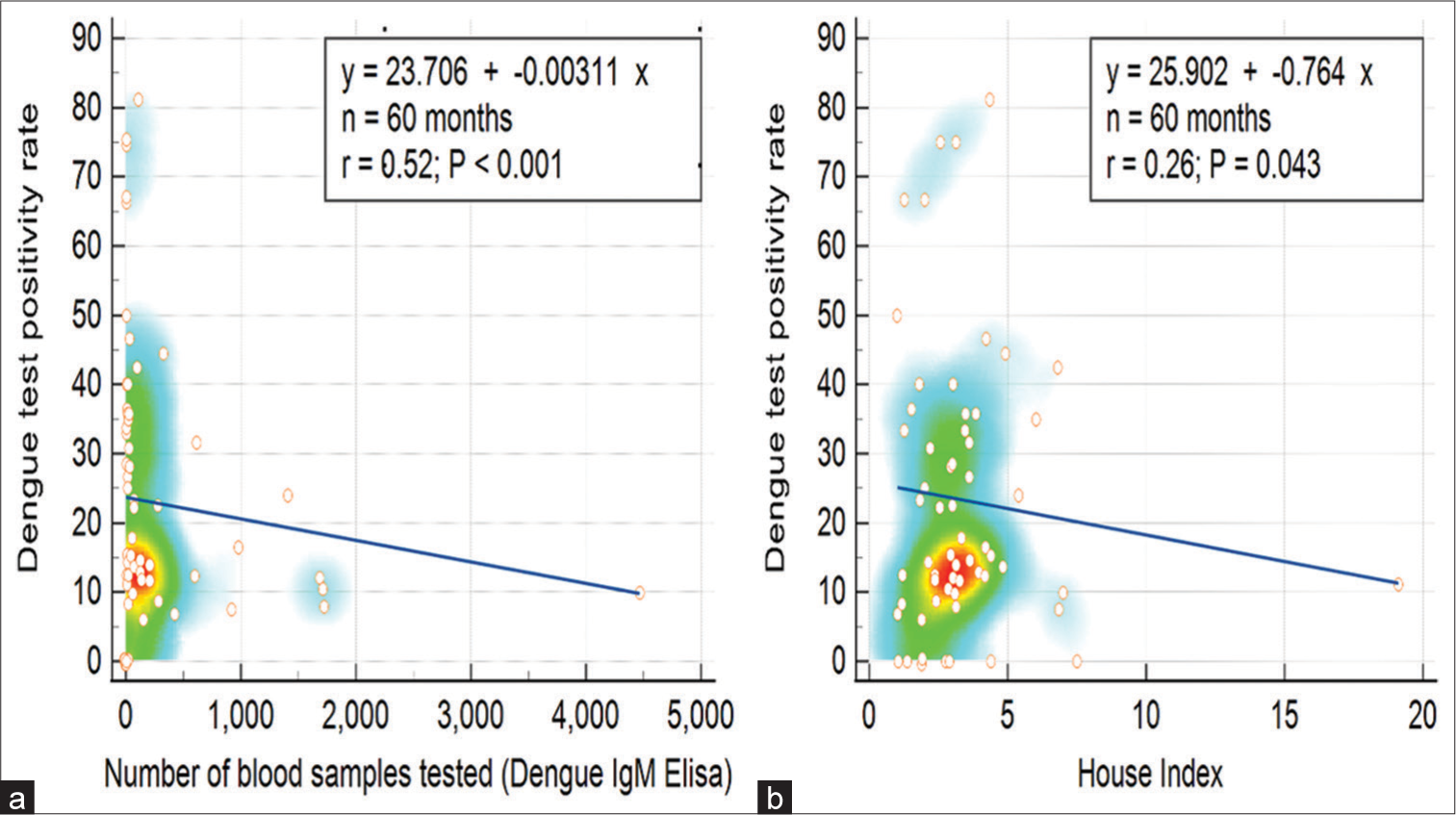
- Heat map and scatter plots depicting the linear relationship between the dengue test positivity rate as the dependent variable and the independent variables: (a) the total number of blood samples tested (Dengue immunoglobulin M enzyme-linked immunosorbent assay) and (b) the house index (month-wise).
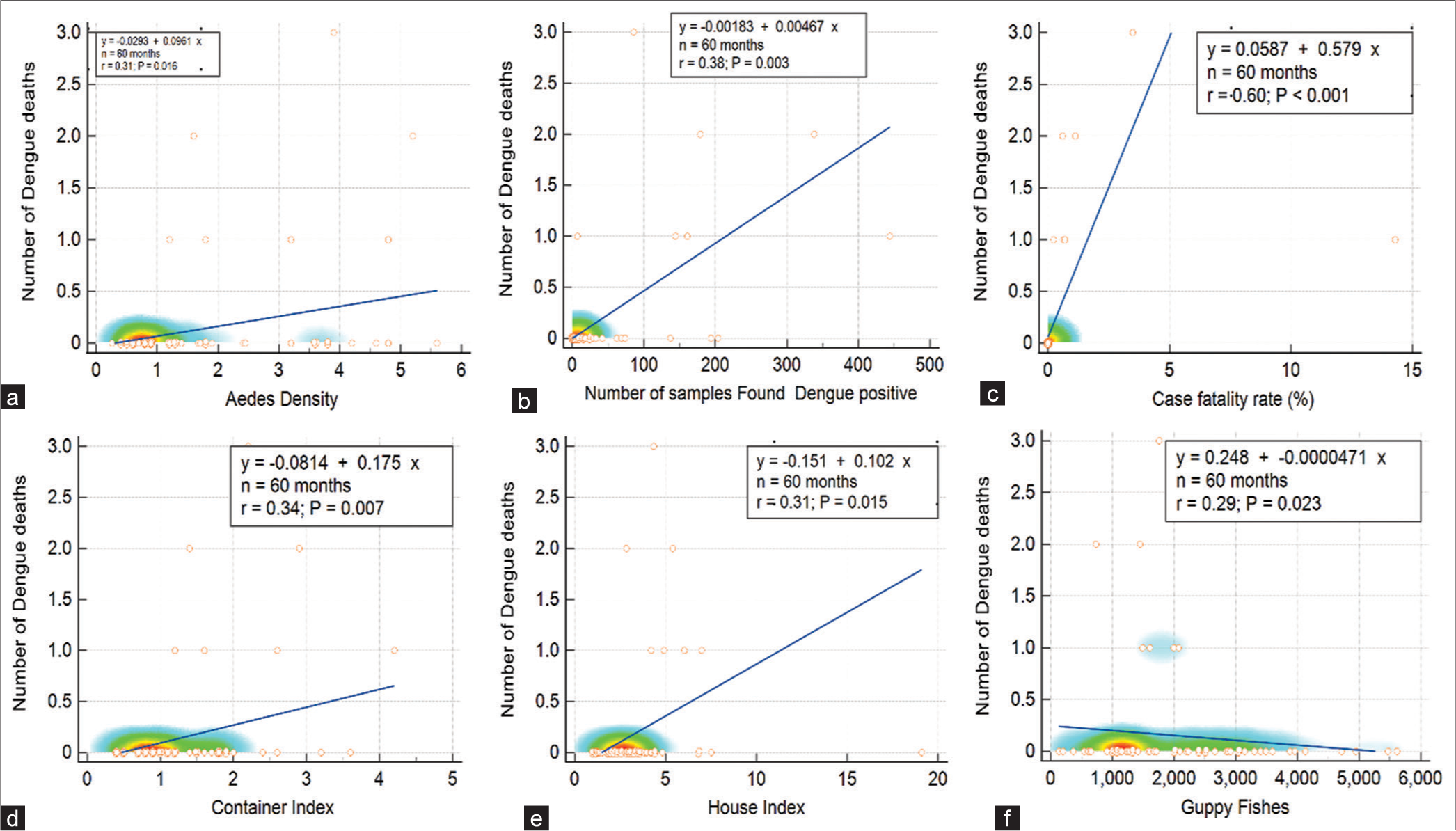
- Heat map and scatter plots depicting the linear relationship between the number of dengue deaths as the dependent variable and the independent variables: (a) Aedes density, (b) number of samples found to be dengue positive (Dengue cases), (c) case fatality rate, (d) container index, (e) house index and (f) number of guppy fishes introduced (as a public health intervention) (month wise).
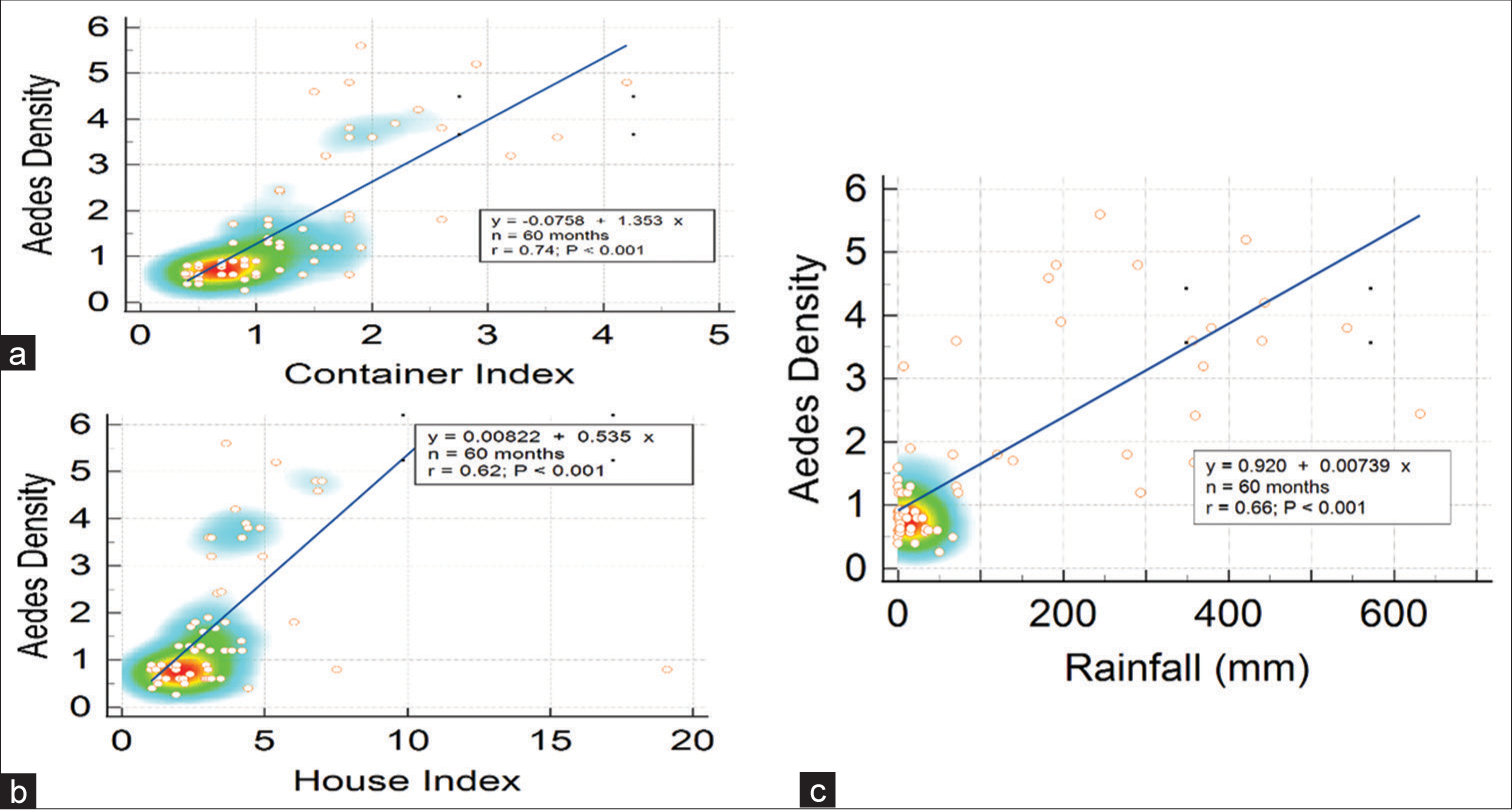
- Heat map and scatter plots depicting the linear relationship between Aedes density as the dependent variable and the independent variables: (a) Container index, (b) house index, and (c) rainfall (mm).
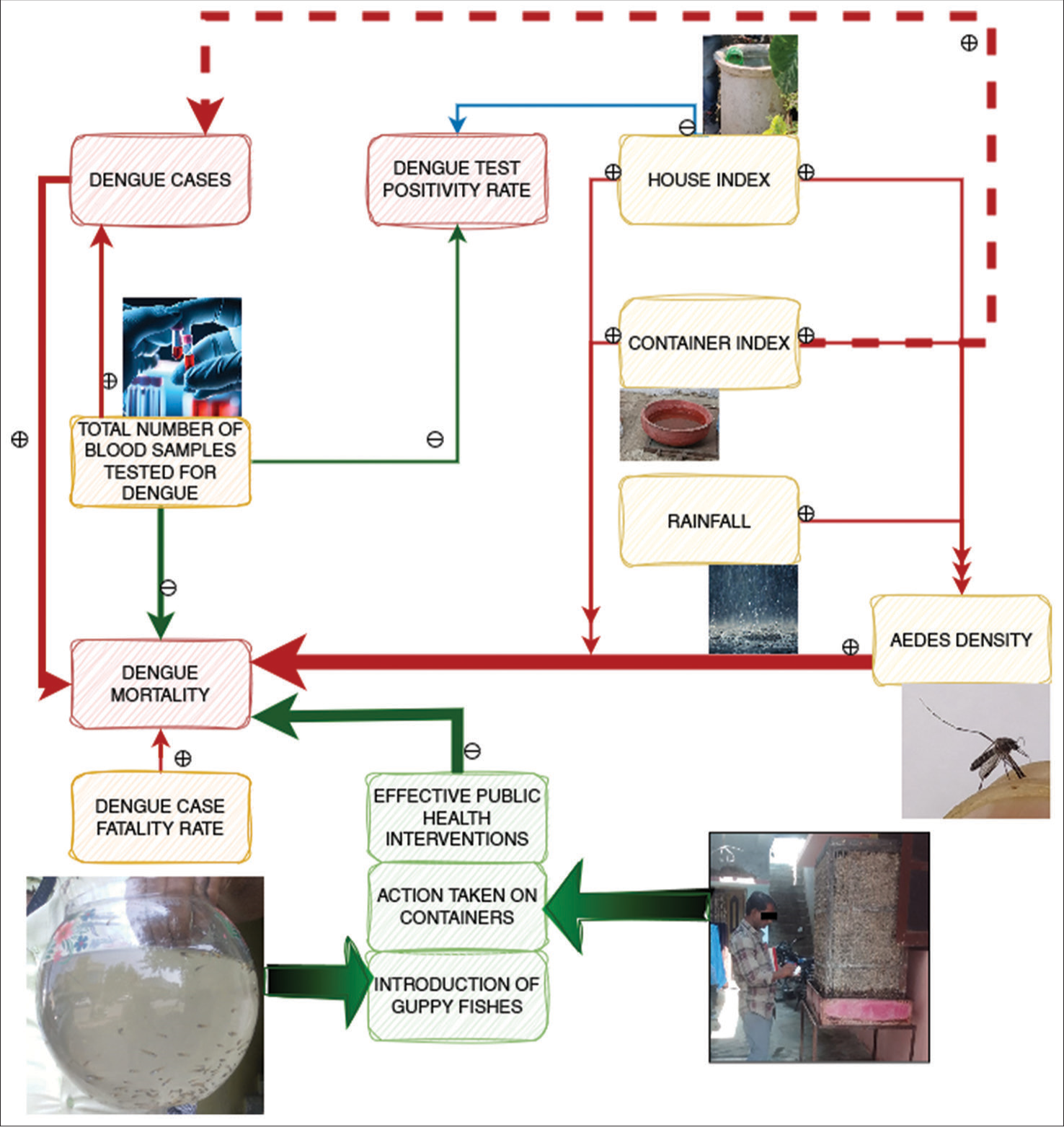
- The interrelationship among various dengue-related parameters and their significant determinants.
Through univariate and multivariate regression analyses, we determined that the higher container index, house index, and total blood samples tested for dengue were significant determinants of the total number of dengue cases. The house index and the total number of blood samples tested for dengue also demonstrated a significant negative correlation with the dengue test (serum IgM) positivity rate.
Regarding dengue-related mortality, our study revealed that environmental factors, including Aedes density, Container index, and House index, as well as dengue-related clinical parameters such as the total number of samples tested and the number of samples found to be dengue positive (Dengue cases) and CFR, were significant determinants of the absolute number of dengue deaths. Moreover, the public health interventions of introducing guppy fishes and taking action on containers exhibited significant success in decreasing the absolute number of dengue deaths. Finally, we found that the container index, house index, and rainfall were significant determinants of Aedes density.
DISCUSSION
Dengue burden of Nagpur
Over five years, from 2018 to 2022, 17,306 serum samples were subjected to dengue IgM testing using the ELISA method in Nagpur city, with 2470 cases being identified and an overall test positivity rate of 14.27%. The monthly dengue test positivity rate exhibited an IQR of 6.4121–24.2778 with a median of 15.30%. Comparatively, the mean monthly dengue positivity rate in India fluctuated between 7.7% and 37% during 2014–2017, as evidenced in the literature.[8]
The spatiotemporal dynamics of the dengue incidence rate over five years in Nagpur city revealed a consistent downward trend, notwithstanding an annual incidence rate higher than India’s national average [Figure 1c]. This discrepancy may be attributed to the city’s amplified population density in contrast to India’s mean population density within the same timeframe. Specifically, the population density of Nagpur escalated from 1100 individuals/km2 in 2018 to 1200 individuals/km2 in 2022, likely contributing to the observed increase in the incidence of dengue infection.[5] In contrast, India’s population density stood at 416.46 people/km2 in 2018 and 431.11/km2 in 2022.[9] Dengue transmission is intrinsically linked to population dynamics, particularly within urban settings; multiple social and environmental factors contribute to its prevalence. These factors include population density, human mobility, access to reliable water sources, and water storage practices, all of which can influence the transmission of dengue fever.[1]
Across a 5-year timeframe, Nagpur City experienced an average CFR of 0.43%, accompanied by an SD of 0.3438%. Comparatively, the annual CFR for Nagpur exceeded that of India, likely attributable to the augmented incidence of dengue [Figures 1c and d]. The CFR for dengue fever is subject to considerable variation, contingent on the location and severity of the outbreak, as well as additional factors such as age and comorbidities. Notably, a positive correlation exists between dengue incidence and CFR, such that heightened incidence rates frequently correspond with more severe outbreaks, overwhelming healthcare systems and driving up mortality rates.[3]
During the period spanning 2018–2022, Nagpur City has demonstrated a noteworthy decline in the incidence rate, number of dengue cases, and CFR associated with dengue infection. The decline in the incidence rate and CFR of dengue cases observed in our study may be attributed to multiple factors, including public health interventions and disease surveillance.
Over five years, from 2018 to 2022, Nagpur City exhibited a remarkable reduction in the incidence rate, frequency of dengue cases, and the associated CFR. This decrease can be ascribed to a multitude of factors, including but not limited to interventions in public health and improved disease surveillance systems. The decline in both the incidence and CFR of dengue cases highlights the efficacy of these interventions, which have likely mitigated the impact of dengue fever in Nagpur City.
Determinants of dengue transmission and related parameters
Our study demonstrated that the container index, house index, and the number of blood samples screened for dengue are salient predictors of the total number of dengue cases. The container index, denoting the percentage of water-filled containers containing immature mosquito stages, and the house index, measuring the percentage of houses infested with mosquitoes, are established determinants of the level of mosquito breeding and the risk of dengue transmission. These results suggest that targeted control measures of mosquito breeding sites and reduction of mosquito infestation in residential areas can be practical approaches to mitigate the impact of dengue. Our analysis also revealed that augmenting the number of blood samples tested for dengue can facilitate early detection of dengue cases and contribute to enhanced disease surveillance, enabling expedited public health interventions and mitigating the potential for dengue outbreaks.
Our investigation demonstrated a negative correlation between the house index and the total number of blood samples tested for dengue with the dengue test positivity rate. This observation may suggest an association between increased dengue incidence and decreased positivity, which could be explained by the potential presence of other febrile illnesses, including viral infections, in the population being screened for dengue. In addition, it is plausible that individuals residing in regions with high house index values may also have other domestic hygiene and sanitation-related issues, which may be contributing risk factors for other illnesses. While designing and implementing dengue prevention and control strategies in high-risk areas, it is essential to consider these factors.
Our study has contributed novel insights into the determinants of mortality related to dengue fever, encompassing both environmental and clinical factors. Our findings highlight that Aedes density, container index, and house index, in conjunction with the total number of samples tested and the number of samples found to be dengue positive, as well as CFR, play pivotal roles in the absolute number of dengue-related deaths. Enhanced screening measures for dengue infection may facilitate the identification of the disease at an early phase, thereby halting disease progression and mitigating the likelihood of mortality in confirmed cases. In contrast, a surge in dengue cases is linked to an escalation in the rates of disease-specific fatalities. These insights can inform the development of effective strategies for preventing and controlling dengue outbreaks. In addition, the literature suggests that specific serotypes, including primary infection with dengue virus (DENV)-3 from the Southeast Asian region and secondary infection with DENV-2, DENV-3, and DENV-4, also from the Southeast Asian region, increase the risk of severe dengue infections and consequent dengue mortality and CFR.[10] Therefore, it is imperative to acknowledge the significance of considering serotype-specific CFRs in interpreting the findings. Our study reinforces the crucial interplay between various environmental and clinical factors contributing to the mortality rate linked with dengue fever, emphasising the pressing requirement for further investigation in this domain, including serotype characterisation. Exploring such dimensions would offer a comprehensive understanding of the multifaceted factors that underlie the initiation and perpetuation of dengue outbreaks.
Our investigation revealed a positive correlation between container index and house index, indicators of environmental hygiene, sanitation, and rainfall, with Aedes mosquito density. Aedes mosquitoes are the principal vectors of the DENV, and our results highlight the significance of targeting these environmental determinants to reduce Aedes mosquito populations and consequently decrease the risk of dengue transmission. In addition, our observation that Aedes density increases during the rainy season underscores the need for intensified mosquito control measures during these periods to mitigate the risk of dengue outbreaks. Prior studies have reported significant temporal variations in A. aegypti larval abundance, with typically greater abundance during the wet season.[11] In the aggregate, our investigation emphasises the significance of comprehending the intricate interrelationships among environmental determinants and the transmission of infectious disease, specifically with respect to the development of efficacious approaches for the control and prevention of dengue fever [Figure 6].
Effective public health interventions
The present study provides evidence for the efficacy of public health interventions to mitigate the transmission of dengue fever. Specifically, the introduction of guppy fishes and the targeted elimination of standing water sources were successful in arresting the absolute number of dengue-related deaths. These interventions address key environmental factors that foster the proliferation of Aedes mosquitoes, which are responsible for transmitting the DENV. The introduction of guppy fishes, for example, has been shown to effectively reduce the larval population of Aedes mosquitoes in water containers, while action taken on containers has been demonstrated to eliminate standing water sources that serve as breeding grounds for these vectors. The findings of this study highlight the importance of targeted, evidence-based interventions to effectively control the transmission of dengue fever and the potential impact of such interventions on public health outcomes.[12] This emphasises the imperative need to implement enduring and efficacious strategies for controlling the population of Aedes mosquitoes, thereby abating the burden of dengue in regions where the disease is endemic.
Environmental management strategies and individual actions can effectively reduce the transmission of dengue fever. The most successful approach involves targeting the breeding habitats of Aedes mosquitoes through source reduction and the elimination of unnecessary container habitats. The most effective method to control A. aegypti larvae is through removing or treating containers that may serve as larval habitats in the environment. These interventions may significantly contribute to reducing dengue transmission and play a key role in controlling this disease.[13] In Nagpur’s hot and arid climate, desert air coolers serve as a potential breeding ground for Aedes mosquitoes if the stagnant water in these coolers is not regularly removed. It is imperative to ensure that these coolers are kept dry when not in use to prevent the breeding of Aedes mosquitoes. In addition, subjective measures such as wearing long clothing, using mosquito repellents, and installing window and door screens can reduce mosquito exposure and, consequently, the transmission of dengue fever.[14] In India, despite the awareness of the transmission of dengue fever, there exists an inadequate implementation of preventive measures by the public to curb mosquito breeding. The knowledge of the population regarding dengue does not translate into behavioural changes regarding their immediate surroundings. Moreover, community participation in preventing dengue remains limited, necessitating a significant shift in public perception and behaviour toward adopting dengue-preventive personal actions.[15] In addition to the strategies as mentioned above, supplementary interventions such as traps, comprising of attractants or chemical control methods that incorporate insecticides, may also be employed for Aedes mosquito control. However, it is crucial to note that traps necessitate constant monitoring to evade the unintended consequence of providing breeding grounds for Aedes mosquitoes. Moreover, the use of insecticides must be exercised judiciously and with circumspection, as it is only advisable during critical periods such as dengue epidemics.[14]
Careful consideration of human health risks is necessary when implementing mosquito control measures. Burning mosquito coils, a popular preventive measure against mosquito-borne diseases, adversely affects respiratory health due to increased indoor pollutants such as PM2.5 and carbon monoxide generated during burning. These elevated levels of pollutants are associated with respiratory morbidity and chronic obstructive pulmonary disease. Hence, alternative approaches with fewer adverse health outcomes must be explored while using mosquito coils to prevent dengue transmission.[16] Exposure to mosquito coil smoke may also be a risk factor for lung cancer.[17] While pesticides effectively reduce dengue incidence by controlling mosquito populations, their deleterious effects on human health, including respiratory ailments, gastrointestinal disorders, nervous, immune, and reproductive system damage, and the increased risk of cancer, must be considered.[18] Therefore, alternative measures that are safer and mitigate the hazards associated with pesticide use must be integrated. Source reduction and elimination stand as the most promising techniques to address the propagation of dengue fever, and extensive research is essential in determining the most effective and sustainable strategies.
CONCLUSION
Our study underlines the efficaciousness of public health interventions in mitigating the incidence and fatality rate of dengue fever in Nagpur City over the preceding five years. Despite urbanisation and shifting demographic dynamics, this steady decline in dengue cases corroborates the effectiveness of preventative measures. Introducing guppy fish and container management notably represented significant interventions that reduced dengue-related fatalities. We have ascertained that rainfall and stagnant water in and around households, as deduced by the container index and house index, corresponded to augmented Aedes mosquito densities, the vectors of dengue infection, which resulted in heightened dengue mortality. Stagnant water in and around households has been identified as a risk factor for dengue cases. Therefore, dengue prevention strategies must prioritise tackling the accumulation of stagnant water around households, with enhanced monitoring during the wet season. The success of public health interventions rests on the active role and conscientious behaviour of community individuals who should take personal responsibility and diligently eliminate all stagnant water sources in their households routinely.
Ethical approval
The research/study complied with the Helsinki Declaration of 1964.
Declaration of patient consent
Patient’s consent is not required as patients identity is not disclosed or compromised.
Conflicts of interest
There are no conflicts of interest.
Use of artificial intelligence (AI)-assisted technology for manuscript preparation
The authors confirm that there was no use of artificial intelligence (AI)-assisted technology for assisting in the writing or editing of the manuscript and no images were manipulated using AI.
Financial support and sponsorship
Nil.
References
- Available from: https://www.who.int/news-room/fact-sheets/detail/dengue-and-severe-dengue [Last accessed on 2023 Apr 23]
- Estimating the Dengue Burden in India. Lancet Glob Health. 2019;7:e988-9.
- [CrossRef] [PubMed] [Google Scholar]
- Dengue Infection in India: A Systematic Review and Meta-analysis. PLoS Negl Trop Dis. 2018;12:e0006618.
- [CrossRef] [PubMed] [Google Scholar]
- Dengue/DHF Situation in India: National Center for Vector Borne Diseases Control (NCVBDC) 2023. Available from: https://ncvbdc.mohfw.gov.in/index4.php?lang=1&level=0&linkid=431&lid=3715 [Last accessed on 2023 Apr 23]
- [Google Scholar]
- Nagpur India Metro Area Population 1950-2023. 2023. MacroTrends. Available from: https://www.macrotrends.net/cities/21347/nagpur/population [Last accessed on 2023 Apr 23]
- [Google Scholar]
- India Population 1950-2023. 2023. MacroTrends. Available from: https://www.macrotrends.net/countries/IND/india/population [Last accessed on 2023 Apr 23]
- [Google Scholar]
- MedCalc: A New Computer Program for Medical Statistics. Comput Methods Programs Biomed. 1995;48:257-62.
- [CrossRef] [PubMed] [Google Scholar]
- Epidemiology of Dengue Fever in India, Based on Laboratory Surveillance Data, 2014-2017. Int J Infect Dis. 2019;84:S10-4.
- [CrossRef] [PubMed] [Google Scholar]
- India Population Density 1950-2023. MacroTrends. Available from: https://www.macrotrends.net/countries/IND/india/population-density [Last accessed on 2023 Apr 23]
- [Google Scholar]
- Meta-Analysis of Dengue Severity during Infection by Different Dengue Virus Serotypes in Primary and Secondary Infections. PLoS One. 2016;11:e0154760.
- [CrossRef] [PubMed] [Google Scholar]
- Household Survey of Container-Breeding Mosquitoes and Climatic Factors Influencing the Prevalence of Aedes aegypti (Diptera: Culicidae) in Makkah City, Saudi Arabia. Asian Pac J Trop Biomed. 2012;2:849-57.
- [CrossRef] [PubMed] [Google Scholar]
- Community-Based Use of the Larvivorous Fish Poecilia reticulata to Control the Dengue Vector Aedes aegypti in Domestic Water Storage Containers in Rural Cambodia. J Vector Ecol. 2008;33:139-44.
- [CrossRef] [PubMed] [Google Scholar]
- Risk Factors Associated with Dengue Incidence in Bandung, Indonesia: A Household Based Case-control Study. Heal Sci J Indones. 2020;11:45-51.
- [CrossRef] [Google Scholar]
- Nature Education. 2011. Available from: https://www.nature.com/scitable/topicpage/controlling-dengue-outbreaks-22403714 [Last accessed on 2023 Apr 23]
- [Google Scholar]
- Dengue Awareness, Preventive Behaviours and Aedes Breeding Opportunities among Slums and Slum-Like Pockets in Delhi, India: A Formative Assessment. Trans R Soc Trop Med Hyg. 2021;115:653-63.
- [CrossRef] [PubMed] [Google Scholar]
- Exposure to Mosquito Coil Smoke May be a Risk Factor for Lung Cancer in Taiwan. J Epidemiol. 2008;18:19.
- [CrossRef] [PubMed] [Google Scholar]
- The Health Effects of Pesticides Used for Mosquito Control In: Meyland SJ, Esposito A, eds. Environmental Research. New York: Citizens Campaign for the Environment and Citizens Environmental Research Institute; 2002. Available from: https://www.beyondpesticides.org/assets/media/documents/mosquito/documents/citizenshealtheffectsmosqp.pdf [Last accessed on 2023 Dec 14]
- [Google Scholar]







